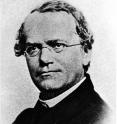Early history of genetics revised
The early history of genetics has to be re-written in the light of new findings. Scientists from the University Jena (Germany) in co-operation with colleagues from Prague found out that the traditional history of the 'rediscovery' of Gregor Johann Mendel's laws of heredity in 1900 has to be adjusted and some facets have to be added. It all began in the year of 1865: Mendel, today known as the 'father of genetics', published his scientific findings about the cross breeding experiments of peas, that went largely unnoticed during his lifetime. His research notes and manuscripts disappeared after Mendel's death in 1884. Only about 1900 three scientists 'rediscovered' the later so called Mendel's laws: the Dutch biologist Hugo de Vries, the German plant geneticist Carl Correns, and the Austrian plant breeder Erich von Tschermak-Seysenegg.
"For 110 years many believed it to be like that," says Prof. Dr. Uwe Hoßfeld, leader of the Research Group Didactics of Biology of the University Jena. "But in reality there were four direct protagonists, 'rediscoverers' of Mendel's laws" as the historians of science and biologists found out recently. Moreover it was assumed that the research went on in parallel and independently. "The so far unknown and now edited correspondence of the brothers Armin und Erich von Tschermak-Seysenegg from 1898-1901 leads to a correction of the former assumption," according to Dr. Michal Simunek. Amongst other things the researchers could prove that some of the scientists should indeed exchange plant seeds and corresponded about the research results in their letters.
Recently two volumes dealing with selected problems of the early Mendel research from the scientific series 'Studies in the History of Sciences and Humanities' have been published. Volume No. 27 for the first time releases the so far unknown personal correspondence from the period between 1898-1951 of the brothers Armin and Erich von Tschermak-Seysenegg, the former being physiologist and the latter a plant breeder. The vast majority of them has been identified by Dr. Simunek in the family possession of Armin's grandson, Dr. Armin Tschermak von Seysenegg Jr. From 1900 Armin Tschermak von Seysenegg presented several writings which show that apart from de Vries and Correns his younger brother Erich took part in the research about Mendel's laws. However he excluded himself from the ranks of the so-called rediscoverers in spite of his active participation in the events of 1900 and 1901.
What were the reasons? Why did he step back and leave all the glory to his younger brother Erich? "The two of them were tied by such an unusual brotherly love that is otherwise rare amongst scientists," Hoßfeld reports on one possible reason. Erich took the credit as the 'rediscoverer' for a long time. He died in 1962. Armin, who died ten years earlier, however remained unknown person about these particular achievements to the public and thus allowed his brother's to overshadow him. At the same time the eye physiologist and later professor in Prague seemed to contribute especially as far as the statistical analysis concerned. Armin was widely interested in the subject of Mendel's laws (especially in the numeric ratio). Therefore his younger brother extensively consulted him on these problems. It can be assumed that the papers Erich Tschermak von Seysenegg presented in 1900 and 1901 respectively about the 'rediscovery' were actually the results of an intense co-operation with his older brother Armin. It is difficult though to reconstruct the whole amount of this fraternal teamwork as there are only a few of the older brother's letters still surviving. "After these new findings the traditional view of the early history of genetics has to be reviewed," both scientists are sure.
The second contribution to the history of the Gregor J. Mendel related research (Volume No. 28) contains the correspondence of Mendel's first biographers, among them Willam Bateson, Hugo Iltis and Erich Tschermak von Seysenegg, with Mendel's two nephews, Dr. Alois and Ferdinand Schindler, from the period between 1902-35. After 1900 the nephews became the most important sources for the biographical portrayal of Gregor J. Mendel. Their writings are mostly concerned with the family history and the last part of Mendel's life. This correspondence is published in such comprehensive volume for the first time.
In the German Research Council project about the early history of genetics in Bohemia and Moravia, Jena scientists co-operated with researchers from the Academy of Sciences in Prague as well as the Moravian Museum in Brno.
Source: Friedrich-Schiller-Universitaet Jena
Other sources
- Early history of genetics revised: New light shed on 'rediscovery' of Mendel's laws of heredityfrom Science DailyTue, 3 May 2011, 22:30:29 UTC
- Early history of genetics revisedfrom PhysorgTue, 3 May 2011, 15:30:37 UTC
